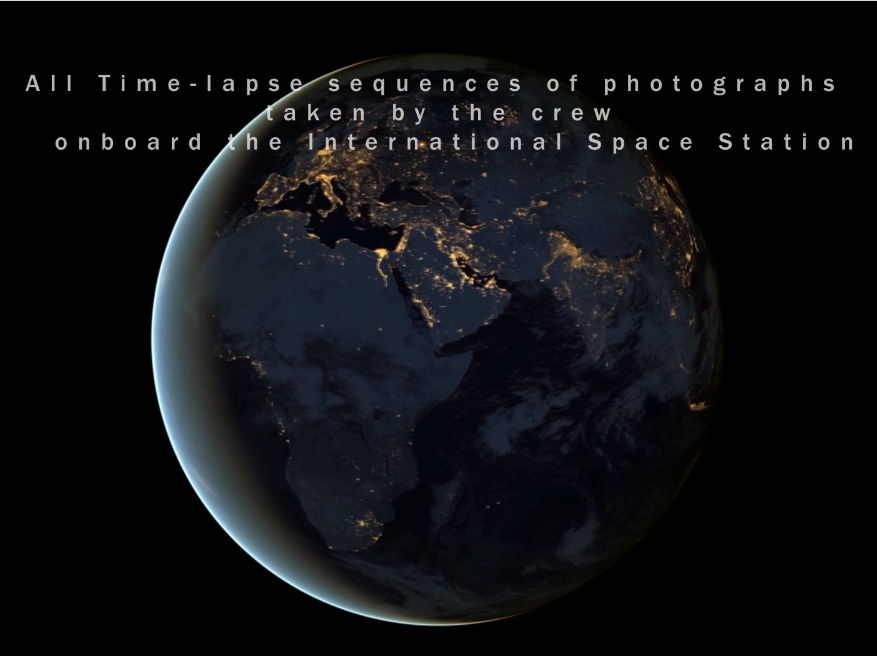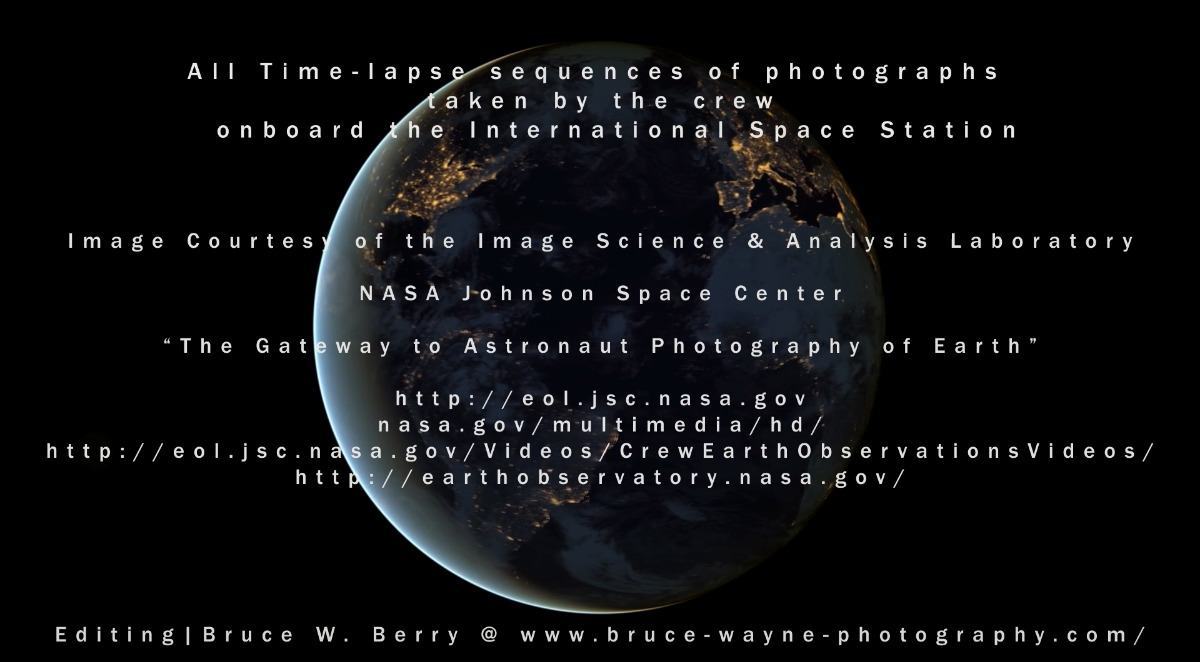
“All Time-lapse sequences were taken by the astronauts onboard the International Space Station (ISS) (Thanks guys for making this available to the public for use!) Hope you all enjoy it and thanks for watching!

🌎
Edited by: Bruce W. Berry
Image Courtesy of the Image Science & Analysis Laboratory,
NASA Johnson Space Center, The Gateway to Astronaut Photography of Earth”
eol.jsc.nasa.gov
eol.jsc.nasa.gov/Videos/CrewEarthObservationsVideos/
nasa.gov/multimedia/hd/
🌍
https://fstoppers.com/timelapse/timelapse-space-will-leave-you-humbled-3516
earthobservatory.nasa.gov/
All rights reserved to their respective owners.
Edited by: Bruce W. Berry
Image Courtesy of the Image Science & Analysis Laboratory,
NASA Johnson Space Center, The Gateway to Astronaut Photography of Earth"
eol.jsc.nasa.gov
eol.jsc.nasa.gov/Videos/CrewEarthObservationsVideos/
nasa.gov/multimedia/hd/
earthobservatory.nasa.gov/
Footage Note: The slower video represents a closer resemblance to the true speed of the International Space Station; this footage was shot at one frame per second. Clips are all marked with an *.
Locations of Footage in the order they appear:
1. A Jump over the Terminator
2. Sarychev Volcano
3. From Turkey to Iran*
4. Hurricane Irene Hits the US
5. Indian Ocean to Pacific Ocean Through the Cupola*
6. Central Great Plains at Night*
7. Aurora Borealis over the North Atlantic Ocean*
8. Aurora Borealis from Central U.S.*
9. Up the East Coast of North America*
10. Myanmar to Malaysia*
11. Western Europe to Central India
12. Middle East to the South Pacific Ocean
13. Aurora Borealis over Europe*
14. City Lights over Middle East*
15. European City Lights*
16. Northwest coast of United States to Central South America at Night
17. Moonglow over Canada and Northern U.S.*
18. Stars from the Pacific Ocean (1)
19. Stars from the Pacific Ocean (2)
20. Stars from the Pacific Ocean (3)
21. Stars and the Milky Way over the Atlantic*
22. The Milky Way and Storms over Africa (1)
23. The Milky Way and Storms over Africa (2)
"Astronauts have used hand-held cameras to photograph the Earth for more than 40 years, beginning with the Mercury missions in the early 1960’s. Crew members in space have taken nearly 750,000 photographs with Hasselblad, Linhof, Rolleiflex, and Nikon hand-held film cameras. Beginning in 1995, digital cameras were introduced on Shuttle missions. Today on the International Space Station all Crew Earth Observations (CEO) imagery is taken with a digital camera (see Munich International Airport, Germany for resolution information). The majority of these photographs are Earth-looking views. The remaining images show satellite deployments and activities outside the space craft (EVA’s--extra-vehicular activities).
Astronauts are trained in scientific observation of ecological, geological, geographic, oceanographic, environmental, and meteorological phenomena. They are also instructed in the use of photographic equipment and techniques. Preflight training helps the astronauts make informed decisions on which areas and phenomena to photograph. Specific areas of interest are selected by scientists before each six-month flight."
For the purposes of planning Earth observing photography or remote sensing, there are four important points about the orbits of the ISS. Particulars of the orbits depend on the exact altitude of the station, and the exact altitude depends on the frequency that the station is reboosted to a higher orbit.
FACT 1: The station travels from west to east on an orbital inclination of 51.6 degrees. Each orbit takes 90-93 minutes, depending on the exact altitude of the ISS. During that time, part of the Earth is viewed under darkness and part under daylight. The ISS orbital altitude drops gradually over time due to the Earth's gravitational pull and atmospheric drag. Periodic reboosts adjust the ISS orbit. As the ISS orbital altitude decays, the orbit tracks on Earth change slightly.
FACT 2: With each orbit taking 90-93 minutes, there are approximately 16 orbits per day (24 hours). The exact number of orbits per day is usually less than 16 (generally 15.5 to 15.9 orbits/day) depending on the altitude of the ISS. Each orbit shifts to the west by approximately 22.9° of longitude (measured as the position where the orbit crosses the equator).
FACT 3: There is an approximate repeat of orbit tracks over the same area on the ground every 3 days. Again, the ISS altitude will determine how closely the tracks repeat.
FACT 4: The part of the Earth visible to ISS astronauts in daylight changes due to the interaction between the orbit patterns of the station and the rotation of the Earth. The daylight portion of the orbits shifts slightly eastward along track each day. This lighting procession follows an approximate 63-day cycle from a descending track covering the mid-latitudes, to southern hemisphere lighting, to ascending tracks, to northern hemisphere lighting. This cycle, plus seasonal changes in solar incidence, cause the sun illumination angles to vary every time the station passes over a given region.
Hasselblad
Linhof
Hasselblad
Linhof
Maurer
Ansco Autoset
Nikon (film)
Rolleiflex
Skylab S190A
Skylab S190B
Sony HDW-700 High-definition Television Camera
Kodak DCS460 Electronic Still Camera
Nikon D1
Nikon D2Xs
Nikon D3
Nikon D3X
Nikon D3S
Canon Digital IXUS 700
Thanks again to Bruce Berry, The ISS Station, and Nasa.



.gif)
No comments:
Post a Comment